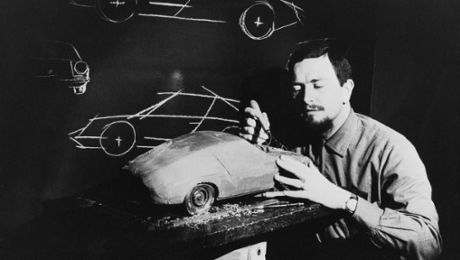Half a century ago, Porsche introduced the Turbo model designation for the flagship 911 series. Since then, the ‘Turbo’ designation has become synonymous with the range-topping Porsche models, and is no longer solely linked to the 911. Since the 1990s, motorsport-inspired series production cars have been even more track-focused, while the Turbo continues to combine uncompromising sportiness and everyday usability. A Turbo unites driving dynamics with efficiency and tradition with innovation, and represents the technological pinnacle in all Porsche model lines.
Mix of experience and success: from the Turbo look to turbocharging
In addition to being the crowning glory of eight 911 generations and the embodiment of a technology, the term ‘Turbo’ also denotes the particular ‘Turbo look’ and turbocharging in general. Even before the 911 Carrera was offered with a ‘Turbo look’ in autumn 1983, Porsche engineers built a 911 Carrera Cabriolet ‘Turbo look’ in Silver Rose Metallic as a pre-production car for then-CEO Peter W. Schutz. The vehicle’s specification included not only the wide body and spoiler of the 911 Turbo, but also its suspension and the four-piston fixed-calliper brakes. Between 1983 and 1993, Porsche created wide-body ‘Turbo-look’ versions of the G-Series and 964 generations. The following models were available in ‘Turbo-look’ versions: 911 Carrera 3.2 Coupé (1983 to 1989), 911 Carrera 3.2 Targa and Cabriolet (1984 to 1989), 911 Carrera Speedster (1988 to 1989), 911 Carrera 2 Cabriolet (1992 to 1993), 911 Carrera 2 Speedster (1993) and the anniversary edition 911 Carrera 4 Coupé ‘30 years of the 911’ (1993).
In 1995, Porsche launched the first 911 GT2. This track-focused GT car was based on the 911 Turbo of the 993 generation and featured an air-cooled 3.6-litre twin-turbo flat-six. In the years that followed, Porsche would also use turbocharging in the 911 GT2 of the 997 generations. As part of the new generation of engines, twin turbocharging was introduced in the broader 911 Carrera range from 2015. From 2016, Porsche also used turbocharging in the four-cylinder boxer engines of the 718 model series. The result: greater power and torque combined with lower fuel consumption.
Turbo as a synonym for pioneering achievements in all model lines
‘Turbo’ has also long been an integral part of the name in other Porsche model lines. It first adorned the Porsche 924 Turbo in 1979, the Porsche 944 Turbo in 1985 and the first 944 Turbo S three years later. The Cayenne Turbo was launched in 2002, and the even more powerful Turbo S in 2005. Porsche launched the Panamera range in 2009, and the first Turbo appeared the same year. Four years later came the top Turbo S variant. Finally, Porsche released the Macan Turbo in 2014.
Five years ago, the ‘Turbo’ moniker appeared for the first time on the Taycan Turbo. The first models in the new series, the Taycan Turbo S and Taycan Turbo, were the spearhead of Porsche E-Performance. The all-electric sports car was thus poised to continue the story of the Turbo model name – albeit this time without an actual exhaust turbocharger – with the most powerful series production models that the sports car manufacturer had in its product portfolio at the time.
Typical Turbo
What do Porsche enthusiasts think of when they hear the word ‘Turbo’? Extravagant rear wings and wheelarches, lightweight construction, air vents between doors and rear wheels, and particularly sporty equipment. They think of special editions, dynamic performance, dramatic power delivery and speed. In addition, a Turbo always combines a wealth of innovations: In the second generation of the 911Turbo, Porsche positioned a charge-air cooler below the rear spoiler. This was a world first in a production car, and again an innovation derived from motor racing. Porsche presented the 996-generation 911 Turbo with PCCB ceramic composite disc brakes. The 911 Turbo (997) was the first series-produced petrol engine to employ turbochargers with Variable Turbine Geometry (VTG). Another characteristic feature of the Turbo is that the sports car manufacturer puts together a new Sport Chrono package for each model. With each new Turbo, Porsche ventures ever closer to the limits of what is possible. Comfortable and suitable for everyday use – that’s typical Turbo as well.

